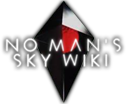Naming conventions, new biome families and other changes

"I do exist!"
While we wait for Nodiddly to provide the proper source for the recent changes - and I really want to know how Chromatic Fog is supposed to be missing in those despite being ingame in the community week system - there are also other things to discuss. For one the biomes of the Exotics do indeed now seem grouped and unless we find name mixups again soon, we might need to give all of them their own biome group for planet types on the biome page. We can still make a secondary assortment there for Anomalous or Exotic planets in general as a sorting idea but they would get their own.Thamalandis (talk) 22:36, 25 November 2018 (UTC)
The source is NMS_LOC4_ENGLISH. The names used in the descriptions in the lower section are made up fan names. --Nodiddlyoddly (talk) 22:43, 25 November 2018 (UTC)
- Gorla can show you how to copy the raw file data into a proper page to make it a source. However you still didn't tell me a) how Chromatic Fog went missing and also b) Community names do have a value here. So they would at least be mentioned in future pages... at least for more common once like The Glass.Thamalandis (talk) 22:47, 25 November 2018 (UTC)
Chromatic fog isn't an exotic planet type, it is from the new "red" biome type...that is why I didn't put it on this page. You can find the names for that biome in the NMS_Update3_English file. I believe we should use the names in the files over fan made names as much as possible. --Nodiddlyoddly (talk) 22:49, 25 November 2018 (UTC)
- "Red"... the only thing red on that is the sky the rest is desaturiated. I really fear those are literally developer SHORT tags for the files and not proper names. We should actually collect the current type names (E.G. Chromatic Fog) and pick one of them to represent the groups. If the names aren't used ingame (Scorched, Irradiated, Toxic etc. are) then we shouldn't either. Thoe are literal short tags. We can use them to make an early presorting though. Also I did say we can use the official type names for the assortment. Common community names - for example the glass which matches the event logs in abandoned stations - are named that way for good reason. They are not to be the main page name, just mentioned ON that page. We also differentiate Exotic noses by community names. If we went by part data they surely would be tagged by a stub XYZ_23D numeric. Great wiki names.Thamalandis (talk) 22:53, 25 November 2018 (UTC)
Correction, it is used by the red/blue/green biomes, not just red. It is a possible description for all three of those planet types. I highly suggest you check out the language files instead of relying on how things appear in game. --Nodiddlyoddly (talk) 22:55, 25 November 2018 (UTC)
- To match game reality against your answer: Red/Blue/Green describes the STARS. That is where it can spawn. Yes it only spawns in irregular stars and is part of all three. Which further proves that is NOT a group name at all. It is a star order.Thamalandis (talk) 22:57, 25 November 2018 (UTC)
I don't even know what you're talking about. Each star colour has a special planet type, for example: red star = REDBIOME1 = "Crimson %PLANETCLASS%", green star = GREENBIOME1 = Planetary Anomaly, blue star = BLUEBIOME2 = Lost Blue %PLANETCLASS%. Each colour has a few possible descriptions, some share descriptions. It is much clearer when you actually look at the language files. --Nodiddlyoddly (talk) 23:02, 25 November 2018 (UTC)
- Which are all not named as you claim and PAK files. Which a normal editor cannot even read. Why do you think you are asked to transcribe it in the first place. If you want me to crossexamine data you need to make it accessible.Thamalandis (talk) 23:07, 25 November 2018 (UTC)
What are you talking about? Find NMSARC.86055253, extract the files with PSARC tool. Use the latest mbin compiler on the language files I mentioned. Read the files in your favorite text editor. Those are all the steps. --Nodiddlyoddly (talk) 23:09, 25 November 2018 (UTC)
